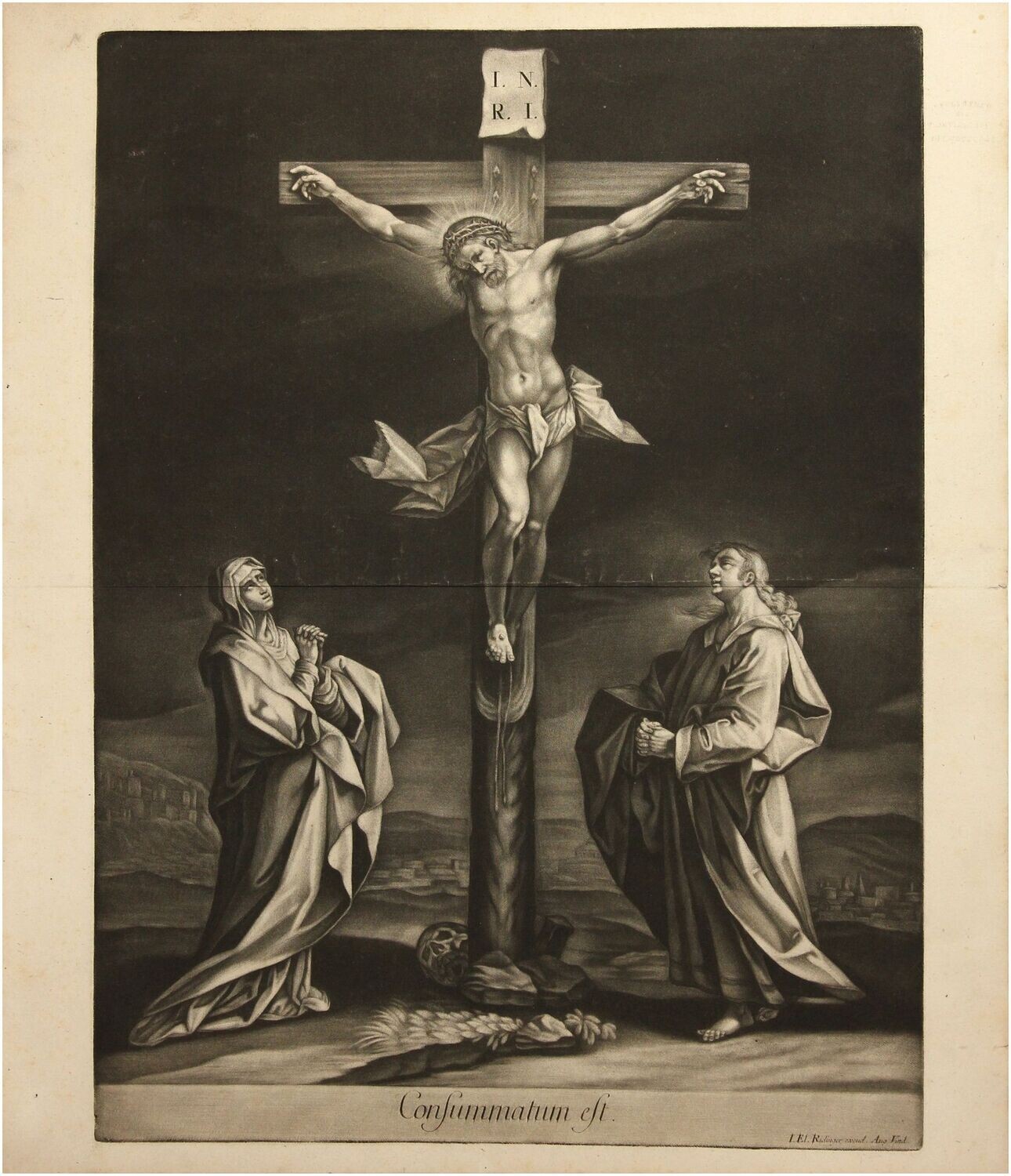Ridinger, Johann Elias (1698-1767), Nächtliche Kreuzigungszene
Johann Elias Ridinger(1698 Ulm - 1767 Augsburg). Consummatum est. Schabkunstblatt, 56 x 42 cm (Plattenmaß), 59,5 x 51,2 cm (Blattgröße), rechts unten in der Platte signiert und ortsbezeichnet „I.[ohannis] El.[ias] Ridinger excud.[it] Aug.[usta] Vind.[elica]“. Thielemann
1274,3
- Kräftiger Druck. Mittig geknickt, an den Rändern minimal braunfleckig, sonst wohl erhalten.
- Das Licht im Dunkel der Nacht
-
Auf diesem großformatigen Blatt schöpft Johann Elias Ridinger die ästhetische Wirkung der Schabkunstmanier aus. Bei der Schabkunst oder Schwarzkunst, die auch unter dem Namen Mezzotinto geläufig ist, wird die Kupferplatte mit dem Wiegeeisen oder der Roulette vollständig aufgeraut, so dass ein Abdruck in diesem Zustand eine tief schwarze Fläche erzeugen würde. Aufgrund der für das Schwarz relevanten feinen Plattenstruktur können nicht einmal 100 Blätter in hoher Qualität in Schabkunstmanier gedruckt werden. Mit dem Schabeisen wird die aufgeraute Plattenoberfläche dort, wo eine helle Partie entstehen soll, geglättet, wobei ein stufenloser Übergang vom Dunkel ins Helle möglich ist. Mit dem Schabeisen wird das Licht gleichsam in die Dunkelheit eingearbeitet, so dass das Dargestellte aus der Dunkelheit hervorzutreten scheint. Da nicht die Platte eingeritzt wird, sondern eine Glättung ihrer Oberfläche erfolgt, werden die Formen nicht von Liniengefügen bestimmt, sondern durch weiche Übergänge erzeugt, woraus die für ein druckgrafisches Verfahren ungewöhnlich malerische Wirkung der Schabkunst resultiert, wie sie sich beispielsweise in der Maserung des Holzes oder dem Inkarnat Christi zeigt.
Durch die Schwarzkunstmanier ist die mit dem Tode Christi eintretende Verdunkelung der Welt auf Ridingers Bild in besonders eindrucksvoller Weise vor Augen gestellt. Wie auf den Gemälden Matthias Grünewalds oder Peter Paul Rubens Münchner Christus in der Einsamkeit
verschwindet die Welt in der Dunkelheit. Sie ist erloschen, wüst und leer, so unfruchtbar wie die kargen Felsschollen Golgathas, auf denen Maria und Johannes stehen. Und doch strahlt Christus im Tod am Kreuz hell auf. Er wird zum Lichtkörper, zum Licht der Welt, das Maria und Johannes innerlich erleuchtet, vom Tod zum Leben führt, so wie die abgestorbene Natur unter dem Kreuzestamm, dort, wo das herabfließende Blut den Boden berühren wird, wieder aufblüht. Gerade durch die Schabkunst und Ridingers virtuosem Umgang mit dieser Technik wird die Polarität von Dunkelheit und Tod einerseits und Licht und Leben andererseits auf höchst dramatische Weise anschaulich, wobei das großformatige Blatt zugleich eine für die Druckgrafik außergewöhnliche Fernwirkung entfaltet.
zum Künstler
Ab 1711 ist der junge Johann Elias Ridinger als Gehilfe für den Ulmer Maler Christian Resch tätig. 1713/14 wechselt er dann zu dem Tier- und Pflanzenmaler Johann Falch nach Augsburg, wo er sich durch Kopien nach älteren Meistern schult. Auf Empfehlung des Augsburger Malers Gabriel Spitzel weilt Ridinger von 1715 bis 1718 bei dem Grafen Metternich in Regensburg. Bei den häufigen Jagden und in der Reitschule betreibt Ridinger dort ein intensives Studium der Tierdarstellung. Gegen 1718 nach Augsburg zurückgekehrt, wird Ridinger auf der Kunstakademie Schüler des Schlachtenmalers Georg Philipp Rugendas.
Insgesamt umfasst sein immenses Oeuvre rund 1600 Stiche, Radierungen und Schabkunstblätter, die er durch einen eigenen Kunstverlag vertreibt. Daneben war der überaus produktive Künstler auch als Maler tätig. Nach seinem Tode im Jahre 1767 wird der Verlag von seinen beiden Söhnen Martin Elias und Johann Jakob Ridinger weitergeführt.
Auswahlbibliographie
Stefan Morét u. Arnulf Rosenstock: Wer hat das Thierreich so in seines Pinsels Macht? Die Tierdarstellungen von Johann Elias Ridinger, Darmstadt 1999.
Karl & Faber (Hrsg.): Johann Elias Ridinger, München 1979.
Rolf Biedermann: Johann Elias Ridinger 1698 - 1767, Augsburg 1967.
Georg August Wilhelm Thienemann: Leben und Wirken des unvergleichlichen Thiermalers und Kupferstechers Johann Elias Ridinger mit dem ausführlichen Verzeichniss seiner Kupferstiche, Schwarzkunstblätter und der von ihm hinterlassenen grossen Sammlung von Handzeichnungen ; nebst Ridinger’s Portrait in Stahlstich und 12 aus seinen Zeichnungen entlehnten Kupferstichen, Leipzig 1856.

